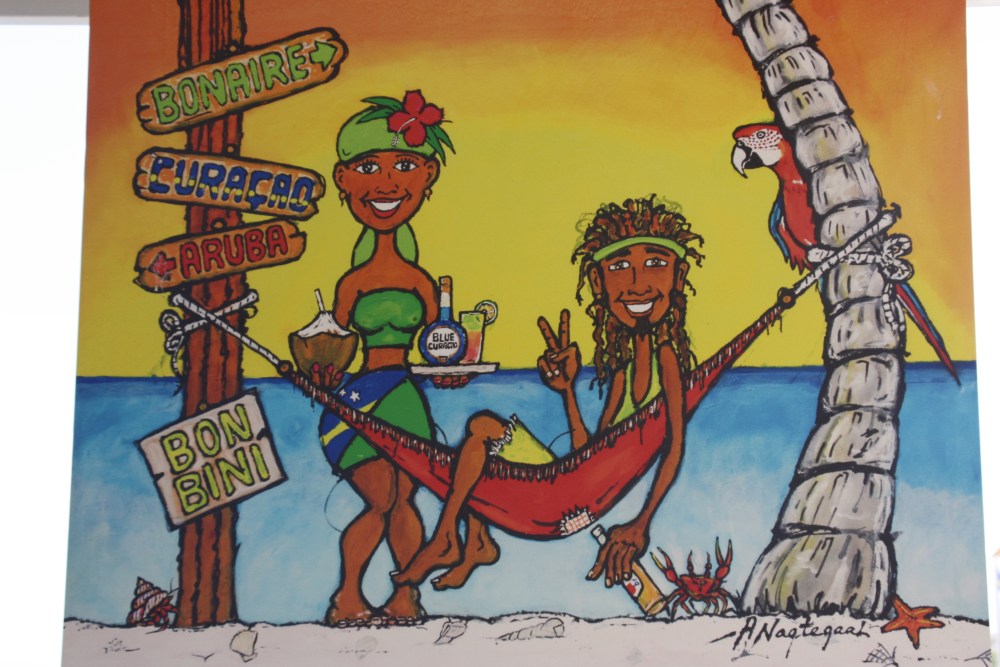
“It’ll take you at least three hours to check in”. “There is nowhere to swim”. “The lagoon is so full, there won’t be anywhere to anchor”. As usual there was plenty of advice on offer from other cruisers, mostly telling us to skip Curaçao. But we decided to go and find out for ourselves.
Unfortunately the forecasted wind for our sail from Bonaire to Curaçao didn’t really materialise and our engine decided it didn’t like the choppy sea and kept threatening to cut out. So it was a rather stressful eight hours until we put down our anchor in Spanish Waters. It was fairly busy and we did end up anchoring a bit too close to another boat but fortunately for us they were a nice Dutch family who didn’t seem to mind. Spanish Water is the main anchorage on the island because it is large and offers good shelter in any weather. However it is a rather murky lagoon and the idea of swimming definitely wasn’t an appealing one. So far not very promising…
On day two we were invited by some lovely Danish cruisers to join in a potluck BBQ on the beach near the anchorage. We went round the corner to the entrance of the lagoon where there was a thin strip of beach, long dock and big hotel. We ended up having a lovely, happy evening swimming, eating, drinking and making lots of new friends. The kids also discovered the hotel pool with its irresistible sprinklers. So far much better…
On Monday we set off on the bus to the capital Willemstad for the famed ‘all-day’ check in. Willemstad is probably my favourite city in the Caribbean. The city boasts beautiful, colourful old buildings and great museums, European style street cafes and chaotic floating fish and fruit markets, plenty of tourist tat for the cruise ships and a real pulsing hardworking city.
We were very thankful we took the kids scooters with us as the check-in process did take the rumoured three hours and we did have to walk all over the town to find all the different departments. But it also gave us our first introduction to this fabulous city. We had to pass the Venezuelan fishing boats calling out their catch on our way to Customs. We had to cross the pretty Queen Emma Floating Bridge to get to immigration. And we got a great look at the Unesco-World heritage listed rainbow coloured streets and enjoyed meeting all the friendly officials. So far much much better…
And so continued our week in Curaçao. The island gets quite a lot of cruisers who sit out hurricane season in its safe harbours and so everything is fairly easy. There is a daily cruisers net, a free morning shopping bus and plenty of social activities. We explored a nearby sunken tugboat, had a delicious lunch from the local vendors in Plaza Bieu at the town market and visited a local resort to eat ice-cream and gawk at tourists. P went windsurfing and the kids spent even more time in the hotel pool. We enjoyed socialising with sailing friends on Johanna, Polanika and 7seas.
We also visited the brilliant Kuna Hulanda museum. The island has a very sad history as it was one of the principal Caribbean slave markets where slaves were bought, sold and traded. Kura Hulanda (Dutch Yard) was itself once a slave ‘vendue’. The museum now is dedicated to the history of the African Holocaust precipitated by the Triangle Trade between Europe, Africa and the Caribbean. The rooms cleverly lead you through an inspiring and beautiful collection of African artefacts before introducing you to the story of slavery in the area.
Curaçao doesn’t have the crystal clear water of Bonaire. It doesn’t feel as isolated or isn’t as laid back. But for us it’s all the richer for it. Curaçao is a country diverse in heritage and ethnicity. In fact, 42 different ethnic groups call the island their home. The island’s residents, most of whom are of European or African descent, represent various cultural heritages and have a strong sense of cultural awareness. The heart of Curaçao’s heritage beats with the rhythm of African culture, and the majority of the island’s population consists of people of African descent. You can see it clearly in the music, language and art. There is also a distinct Dutch flavour, which makes itself known in many different ways. Willemstad is home to the oldest continuously operating Jewish congregation in the western hemisphere since 1651. So add to the mix those locals of Latin American, Jewish, Middle Eastern, and East Indian background, and you can begin to appreciate the complexity that is Curaçao. We found an island with lots of energy, lots of natural beauty and alive with culture and heritage. We’re delighted to have discovered it for ourselves.



































So interesting Anna, thank you for sharing. Great to know that your intrepid spirit of exploration paid off in Curaçao . A good reminder that it’s always worth making the effort… Xxx
LikeLike
Thanks Mattie – on our way to Panama today to explore the San Blas – have so loved Colombia. Lots of love to all xxx
LikeLike